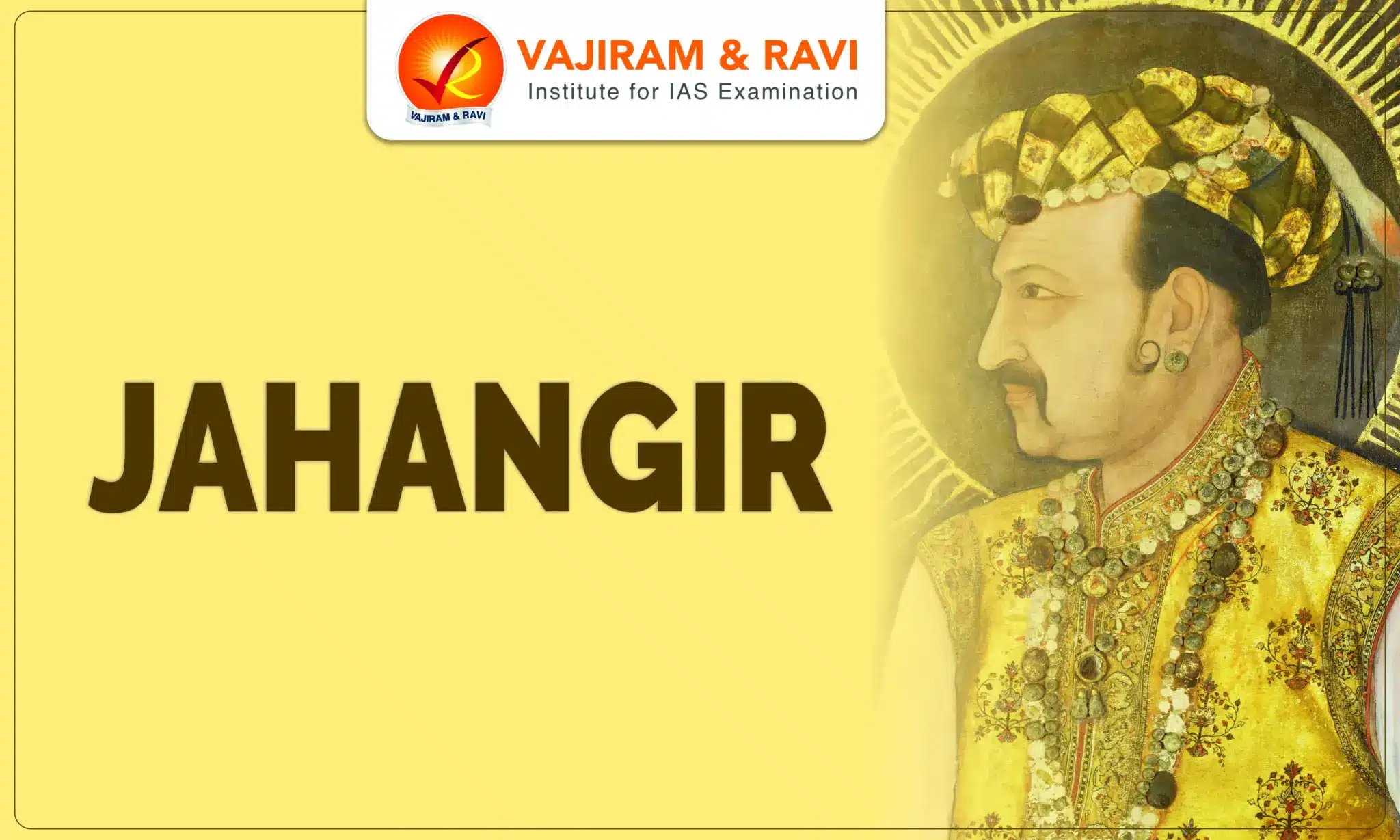Jahangir, the fourth Mughal emperor, reigned from 1605 to 1627 and played a crucial role in consolidating the Mughal Empire. His reign marked a period of cultural flourishing, artistic patronage, and administrative reforms that built upon the foundations laid by his father, Akbar.
Jahangir’s rule saw the continued expansion of the Mughal Empire and significant developments in art, architecture, and governance. Jahangir is well-known for his patronage of the arts, religious tolerance, and love of gardening.
Who is Jahangir?
Jahangir, originally named Nur-ud-din Muhammad Salim (Prince Salim), was the eldest son of Emperor Akbar and his wife Mariam-Zamani. Jahangir was born in 1569 in Fatehpur Sikri and died in 1627 en route to Lahore. His reign, though marked by personal indulgences, witnessed remarkable contributions to the Mughal Empire, especially in the fields of governance, culture, and justice.
- Jahangir, born Salim, was Akbar’s eldest son, named after the Sufi saint Sheikh Salim Chishti, who had foretold his birth. Raised in the royal court, he received education in administration, warfare, and the arts.
- In 1599, eager to secure power, Salim rebelled against his father while Akbar was engaged in campaigns in the Deccan.
- However, despite the rebellion, Akbar named him his successor on his deathbed.
- When Salim ascended the throne in 1605, he took the name Jahangir, meaning “World Seizer.” His reign was challenged by his son, Prince Khusrau, who rebelled with the support of Sikh Guru Arjun Dev.
- The rebellion was swiftly crushed, with Khusrau captured and blinded. Guru Arjun Dev, implicated in the revolt, was arrested and executed, solidifying Jahangir’s grip on power.
Jahangir War and Conquests
Jahangir decided to continue Akbar’s expansionist policies in the Deccan. However, Jahangir’s success was limited due to several issues. He was unable to devote much attention during the critical phase due to Khurram’s revolt. The Mughal nobles were also involved in many intrigues and conflicts to gain an advantage in the Deccan.
- Mewar Campaign: Jahangir finally subdued the Rajput kingdom of Mewar, which had long resisted Mughal control. It was led by his son Prince Khurram (later to become Emperor Shah Jahan) against Rana Amar Singh, the grandson of Rana Udai Singh. The campaign ended with a generous peace treaty in 1614.
- Deccan Campaign: In 1608, Ahmadnagar in the Deccan declared independence under Malik Ambar, who successfully resisted multiple Mughal attacks led by Prince Khurram.
- Malik Ambar not only recaptured territories like Berar and Balaghat but also maintained control over significant regions of Ahmadnagar despite the Mughal efforts to reclaim them.
- Shah Jahan’s Rebellion: During this period, Shah Jahan rebelled against his father, Jahangir, and allied with Malik Ambar. Together, they attempted to capture Burhanpur, but after failing, peace was eventually restored between Jahangir and Shah Jahan. Malik Ambar also settled, temporarily stabilising the Mughal-Deccan conflict.
- Kandahar Campaign: Kandahar, which Akbar captured from the Persians in 1595, fell back into Persian control under Shah Abbas in 1622. Despite Jahangir’s desire to reclaim the city, his efforts were hindered by the rebellion of his son, Prince Khurram who diverted attention and resources away from the campaign.
Influence of Nur Jahan
Nur Jahan Mehrunnisa, also known as Nur Jahan (Light of the World), married Jahangir in 1611. Her father, Itimaduddauala, was a respectable individual. He was given the position of chief diwan. Other members of her family benefited from this alliance.
- Nur Jahan’s elder brother, Asaf Khan, was appointed Khan-i-Saman, a position reserved for nobles. In 1612, Asaf Khan’s daughter, Arjumand Banu Begum (later Mumtaj), married Jahangir’s third son, Prince Khurram.
- Some historians believe Nur Jahan formed a “junta,” causing a split in the Mughal court and driving Shah Jahan to rebel in 1622, feeling Jahangir was under her influence. However, others disagree, noting that Jahangir remained in control of key political decisions until his health declined, as his autobiography reveals.
- Nur Jahan’s political influence led Prince Khurram to rebel against his father, Jahangir, but Mahabat Khan, a loyal general, thwarted the uprising, forcing Khurram to retreat to the Deccan.
- After Jahangir’s death, Nur Jahan sought to crown her son-in-law, Shahryar Khan, but Asaf Khan, her brother and Prince Khurram’s father-in-law, ensured Khurram’s ascension as Shah Jahan. Nur Jahan, who held power for a decade, lost her influence following Jahangir’s death in 1645.
Jahangir Reforms
Jahangir’s reign was notable for significant administrative reforms aimed at improving justice and governance. He worked to streamline the judicial system, promote transparency, and ensure a more equitable distribution of resources and power within the Mughal Empire.
- Chain of Justice: One of Jahangir’s most symbolic reforms was the installation of the Zanjir-i-Adl (Chain of Justice).
- Any dissatisfied subject could pull the chain to request the emperor’s assistance in legal matters, which became a powerful symbol of Jahangir’s dedication to justice.
- Do-aspa and Sih-aspa System: Jahangir introduced the Do-aspa and Sih-aspa systems, allowing selected nobles to maintain more troops without increasing their Zat rank. Under Do-aspa, mansabdars were required to keep double the number of horses compared to their ‘Sawar’ rank, while Sih-aspa required triple the number of horses.
- Rajput Policy: Jahangir continued Akbar’s policy of establishing matrimonial relations with the Rajput Rajas. However, following Mewar’s submission, these marriages became less frequent.
- During Jahangir’s reign, the rulers of Rajputana’s four major states – Mewar, Marwar, Amber, and Bikaner – held mansab worth 5000 zat or more.
- The Rajputs were primarily employed as fortress qil’adars or faujdars.
- Tax Reforms: Jahangir’s administration carried on Akbar’s tax reforms, which aimed to ensure a fair tax system based on the production capacity and wealth of the taxed subjects. These measures alleviated undue pressure on the peasantry while increasing agricultural productivity.
- Religious Policy: Jahangir maintained a policy of religious tolerance, much like his father Akbar, though he showed a more direct patronage toward Islam. He upheld the secular traditions of the Mughal court while also promoting Islamic customs, arts, and culture.
- Relations with the British: Two Englishmen, William Hawkins and Sir Thomas Roe, visited Jahangir during his reign. While the former was unable to obtain the Emperor’s consent to establish an English factory in India, the latter, sent as an ambassador by King James I, was successful in obtaining permission to establish a British factory in Surat.
Jahangir Contributions
Jahangir had less interest in politics and more in the arts, painting, gardens, and flowers. Cultural patronage and a strong emphasis on justice within the Mughal Empire marked Jahangir’s contributions.
- Literature: Jahangir supported writers and poets who crafted remarkable works in Persian and other languages. As a poet himself, he wrote under the name “Nuruddin Muhammad Jahangir” and authored his memoir, “Tuzuk-i-Jahangiri.”
- Architecture: Jahangir built Shalimar Gardens in Lahore. The mausoleum of Akbar in Sikandra, near Agra, begun by Akbar and finished by Jahangir, incorporates elements of Buddhist architecture.
- Additionally, Jahangir’s construction of the tomb of Itimad-ud-Daula, Nur Jahan’s father, marked the first Mughal structure entirely made of white marble.
- Painting: Akbar established the Mughal miniature style, which his son Jahangir elevated. Jahangir, an art enthusiast from a young age, employed renowned Iranian painter Aqa Riza and his son Abul Hasan to enhance the sophistication of Mughal art.
- Under Jahangir’s patronage, the popularity of Muraqas—albums of individually mounted paintings—grew. He shifted emphasis from illustrated manuscripts to album and individual portraits.
Jahangir UPSC PYQs
Question 1: Who among the following Mughal Emperors shifted emphasis from illustrated manuscripts to album and individual portraits? (UPSC Prelims 2019)
(a) Humayun
(b) Akbar
(c) Jahangir
(d) Shah Jahan
Ans: (c)
Last updated on April, 2025
→ UPSC Notification 2025 was released on 22nd January 2025.
→ The UPSC Vacancy 2025 were released 1129, out of which 979 were for UPSC CSE and remaining 150 are for UPSC IFoS.
→ UPSC Admit Card 2025 is expected to release in first week of May for CSE Prelims Exam 2025.
→ The UPSC Prelims 2025 is scheduled to be conducted on 25th May 2025 and UPSC Mains 2025 will be conducted on 22nd August 2025.
→ Apply once through it and aspirants can apply for various government exams conducted by UPSC.
→ The UPSC Selection Process is of 3 stages-Prelims, Mains and Interview.
→ UPSC Result 2024 is released with latest UPSC Marksheet 2024. Check Now!
→ UPSC Toppers List 2024 is released now. Shakti Dubey is UPSC AIR 1 2024 Topper.
→ Also check Best IAS Coaching in Delhi
Jahangir FAQs
Q1. What is Jahangir most famous for?+
Q2. Who defeated Mughal emperor Jahangir?+
Q3. Why did Jahangir revolt against Akbar?+
Q4. Who succeeded Jahangir after his death?+
Q5. What is a famous book written by Jahangir?+















